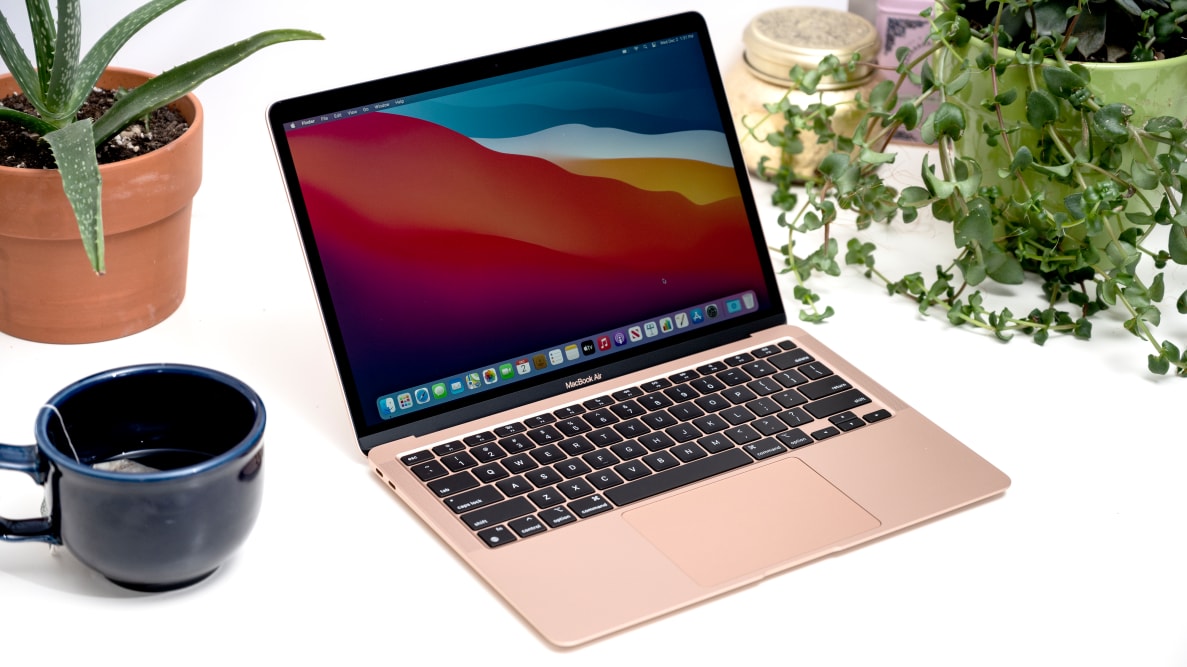Pros
-
Jaw-dropping battery life
-
Incredible performance
-
Iconic build quality
Cons
-
Poor port selection
Apple killed it with the M1 Mac lineup. For the same price (or less!) as its previous Intel-based Macs, you’re getting a laptop that is more powerful, way more power efficient, and way quieter. The difference is particularly pronounced on the MacBook Air, which screams at its $1,000 base price.
While the new MacBook Air comes with jaw-dropping battery life and a blazing-fast processor, it’s not the perfect laptop for everyone—its integrated graphics don’t hold a flame to gaming laptops. However, its processor performance more than makes up for its graphics performance. Video editing and multitasking are a breeze on the Air.
When the M1 Macs came out in November of 2020, we were impressed with their performance but also worried that the new ARM-based processors would have compatibility issues with apps made for the older Intel-based Macs. Thankfully, the M1 MacBook Air put those concerns to rest, with many older apps running almost as well as native apps.
(Editors note: while the MacBook Air M2 and MacBook Pro M3 have since been released, we still recommend the MacBook Air M1 as one of the best laptops under $1,000 and the best MacBook for students.)
About the Apple MacBook Air M1
While the MacBook Air has traditionally been aimed at casual everyday users, the M1 processor is the same that powers the new MacBook Pro, bringing the Air’s capabilities up to par for all but the most demanding tasks. If you plan on doing some casual gaming or video editing, we recommend splurging on the pricier MacBook Pro with an 8-core integrated GPU, which should give you a slight bump in graphics performance over the base model.
Apple MacBook Air M1 specs
- Processor: Apple M1 8-Core Processor, with 7-core integrated GPU (8-core GPU also available)
- Memory: 8 GB RAM (16 GB RAM upgrade also available)
- Storage: 256 GB RAM (512 GB, 1 TB, 2 TB also available)
- Display: 13.3” LED-backlit IPS display at 2560p x 1600p resolution
- Ports: 2 x Thunderbolt 3; 3.5mm headphone jack
- Keyboard and Trackpad: Magic Keyboard with backlighting; Force Touch trackpad; Touch ID sensor
- Camera: 720p webcam
- Graphics: 8-Core Integrated GPU
- Connectivity: Wi-Fi 6; Bluetooth 5.0
- Battery: 49.9 Watt-hour battery
- Weight: 2.8 lbs
- Dimensions: 0.63” x 11.97” x 8.36”
- Warranty: 90 days of complimentary technical support and a one-year warranty
What We Like
Its battery life is long enough to marathon the Lord of the Rings movies
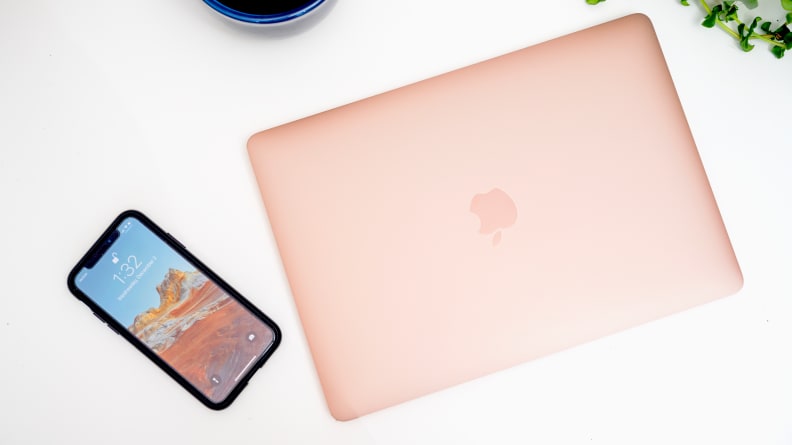
The M1 Air's premium build, blazing speeds, and reasonable price make it the obvious choice for most people.
If you watch all three extended edition movies of the Lord of the Rings trilogy, you will spend 11 and a half hours immersed in Middle Earth. If you watch them all on a fully charged M1 MacBook Air, you will have a little over an hour to spare to tweet about your marathon—just enough time to go back and save the Shire. That’s right, the MacBook Air lasted 12 hours and 49 minutes on our Google Chrome-based battery test. That’s almost 4 hours longer than the HP Spectre x360 14, the longest-lasting Windows machine we’ve tested until now.
The only thing preventing the Air from claiming the battery life crown is the other M1 MacBook, the MacBook Pro 13, which offers almost 14 hours per charge. This discrepancy is due to the MacBook Pro’s slightly bigger battery since they both draw similar amounts of power. Regardless, both the M1 Air and the M1 Pro last much longer than the mid-2020 Intel MacBook Pro 13, which puttered out after 7 hours.
The M1 Silicon processor is leagues ahead of Intel and AMD
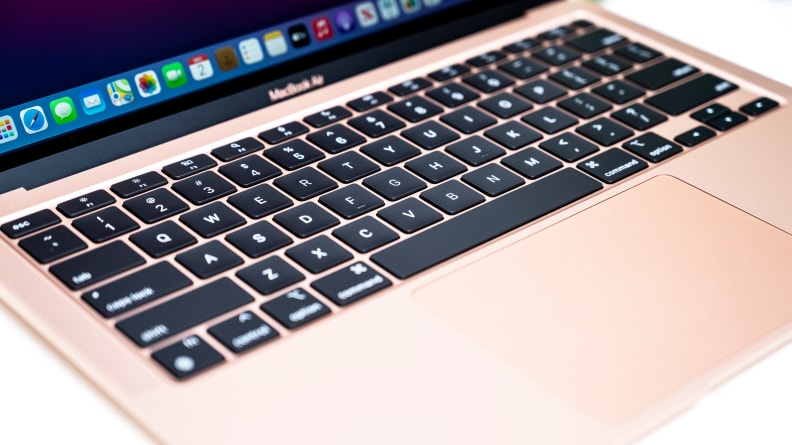
The new M1 processor, built from the same foundations as Apple's iPhone and iPad processors, is the fastest processor we've ever seen at this price.
When you lift the lid, the MacBook Air wakes instantly, regardless of how many programs and tabs you may have open (trust me, I usually have 100+ Chrome tabs and five programs open at any given time). During benchmarks, Apple’s new M1 chip often starts up 10%, 20%, or even 30% or more ahead of the competition. When we tested the M1 MacBook Pro, we didn’t see any discernible performance difference against the MacBook Air. However, the mid-2020 Intel MacBook Pro and Intel MacBook Air feel like two snails in the M1 MacBooks’ tracks.
The only laptop able to keep up with M1 Macs was the Asus ROG Zephyrus G14, which has an AMD Ryzen 9 processor (i.e. AMD’s flagship mobile processor). Compared to the Intel-based Dell XPS 13 9310, one of its closest competitors, the M1 MacBook Air is a whopping 42% faster in the multi-core Geekbench 5 test. In Basemark, which tests web-based performance, the MacBook Air pulls ahead by a still-insane 22%.
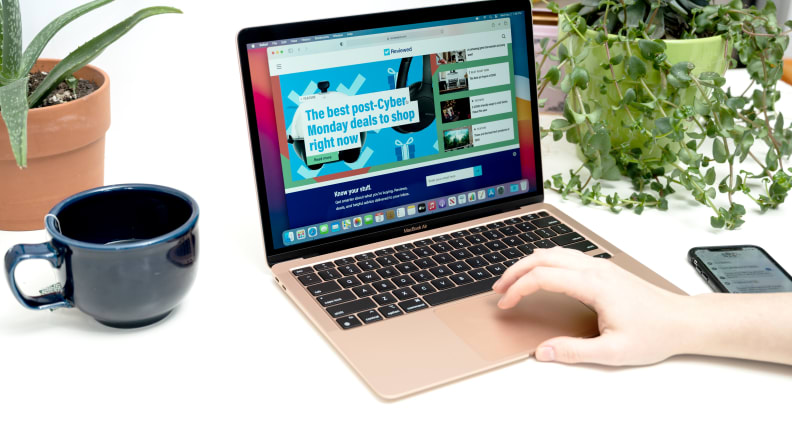
The MacBook Air can handle multitasking incredibly well. It's even capable of light gaming.
The MacBook Air’s GPU performance was about on par with its Windows competition—which is impressive, given that it has no fan. If you do casual gaming, from the occasional round of Rocket League to some less-demanding AAA games, you’ll be pleasantly surprised by the new Air.
We pulled 23 frames per second on World of Warcraft's max settings, which is lower than the 33 fps the new MacBook Pro achieved. The two laptops have the same GPU, but on the Air you only get 7 working cores instead of 8 (this is a common tactic to keep costs down and avoid throwing away the part if one core comes out busted). If you want a full 8-core GPU you can get it on the Air, but you have to step up to the $1,249 model. Both of the M1 MacBooks cream the Intel 13-inch MacBook Pro, which struggled to run 25 frames per second at medium settings (setting 5 of 10)—the M1 MacBook Air runs at nearly 60 frames per second on those same graphics settings.
Where the MacBook Air really shines is in web performance and code writing. The processor feels ridiculously snappy, with windows loading instantly and scripts running smoothly. Unless you need a graphics powerhouse, it’s hard to imagine anyone being dissatisfied with the MacBook Air’s performance.
Rosetta’s Rollout has been extremely smooth so far
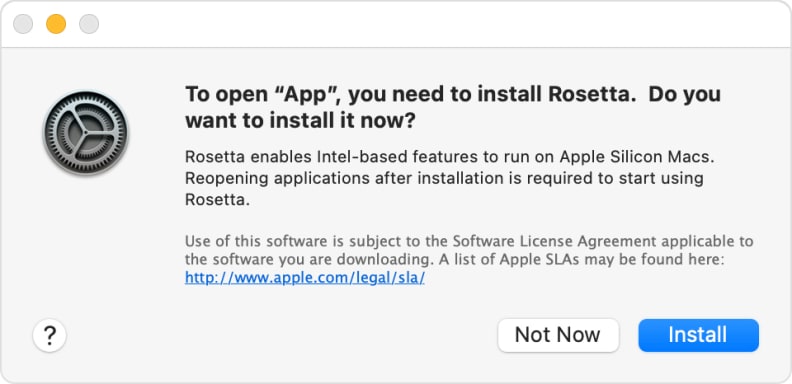
Once you install Rosetta2, it will always launch when you open a non-native app on your M1 machine.
While the M1 processor runs beautifully when used for native ARM apps (such as those written for the new M1 Macs specifically, or iPhone and iPad apps), there are still many apps that must run through Rosetta, Apple’s x86 architecture emulation program. Basically, most PCs run on “x86” architecture, including all the recent Macs and almost every Windows laptop and Chromebook. These new MacBooks use Apple’s new M1 processor, which runs on an “ARM'' architecture, just like iPads and iPhones.
The problem? Apps have to be written for one or the other, so existing x86 apps need to be rewritten to work on the new Macs.
Apple knew that this incompatibility could be a problem, so the M1 Macs ship with Rosetta, an emulator that can run apps that are designed for x86 machines. This doesn’t require any extra work on your part; the computer will ask you to automatically download Rosetta when you try to launch an x86 app for the first time, so your old apps should just work.
When we first started messing with the M1 Macs in November of 2020, the Mac Mini had trouble running Steam and some games meant to run on Mac. Now Steam runs as smoothly on the M-series MacBook Pro and Air as it does on the 2020 Intel MacBook Pro. Many major apps from companies like Google, Adobe, and Microsoft already have native M1 versions, as well.
The only apps we worry about running these days are video games and hardware drivers. We still have trouble launching some indie games like Among Us and Superliminal, although Mac-compatible AAA games have been fine. With hardware, I’ve had smooth sailing with my Bluetooth mice, USB-A audio interfaces, and USB-C keyboards, but there have been a few user complaints about the M1 MacBooks’ compatibility with Huion drawing tablets, for instance.
The new M1 processor can run iOS and iPadOS apps, too
For those of you who are glued to your iPhone or iPad because of its amazing app store, fret no more. You can now run these apps natively on the M1. For these new processors, Apple used the same architecture it has been using on its phone and tablet processors. The obvious problem is the Air does not have a touchscreen, so you will have to get used to using the touchpad. The result is that it’s most useful for apps that are already planned for macOS compatibility, but it would sure be great if Apple just put a touchscreen on its MacBooks (hint, hint).
The MacBook Air is silent and cool (literally)
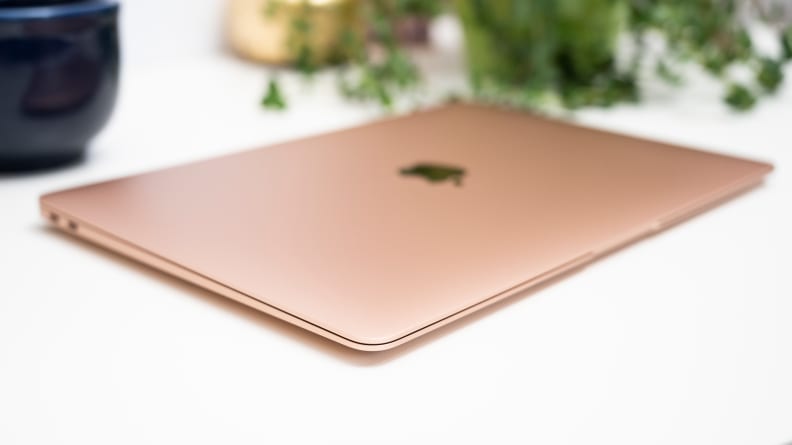
This thin, quiet, and cool laptop makes the perfect companion for trotting around all day.
Usually, a fanless laptop is not a snappy laptop, since it needs to be careful about overheating its processor. However, the M1 MacBook Air is a glorious exception to that rule, with some of the snappiest performance we’ve ever seen from a laptop, period.
Because it’s fanless, the MacBook Air runs silently regardless of how many tasks it’s juggling. More importantly, the Air still manages to stay significantly cooler than the Intel Macs, despite its lack of fans. It rarely feels warm at all.
It’s the same body as the mid-2020 MacBook Air
When the last Air came out in the spring, we were delighted with the changes Apple brought: thin bezels, a beautiful Retina display, and most importantly, the Magic keyboard. The M1 Air is the same as the Intel Air in all but its processor. Otherwise, the M1 Air has the same screen, the same aluminum chassis, and the same glorious keyboard and touchpad.
What We Don’t Like
The port selection is awful
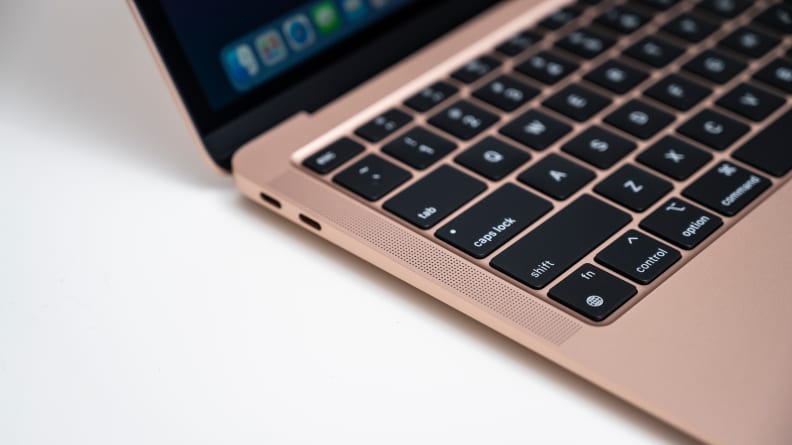
These two Thunderbolt ports and a headphone jack are all you get with the M1 MacBook Air.
The M1 Air comes with two Thunderbolt 3 ports and a headphone jack. Woe be to those who need more than a charger. You will have two ports to plug in displays, add microphones, connect dongles, or access an internal drive, hopefully not all at the same time. Sticking to Bluetooth peripherals and cloud-based services is basically a must for M1 users, given the sparseness of the port situation.
Though some users have reported Bluetooth connectivity issues, we haven’t had any problems. It's possible that some aging hardware peripherals may struggle with driver compatibility on the new M1 Macs, but most should be compatible if they're using standard drivers.
You can’t upgrade your computer
Apple decided to solder the memory and storage directly onto the M1 in order to have a more direct connection between the modules and the CPU, which Apple claims is faster and better for battery life. However, this also means that you have to pay a huge markup to increase storage and you’re stuck with whatever you bought on day one. For many, this won’t be a problem, but we would advise getting the upgraded model with at least 512 GB of SSD space if you don’t want to feel too constricted within a year or two.
This also means that those who were hoping for a Mac with 32GB of memory will have to wait to see what the iMac and the Mac Pro have to offer for their next cycles. Otherwise, you’ll have to stick with an older Mac or a Windows/Linux PC if you want to have more hardware upgradeability.
Should you buy the Apple MacBook Air M1?
Yes, it's one of the best laptops on the market

The MacBook Air M1 is the most ingenious laptop Apple's made in a long time.
The M1 MacBook Air is one the fastest sub-$1,000 laptop by far, and it has the premium build quality and user experience to back up its performance. It has a remarkable 13-hour battery life, it’s silent, it runs faster than any other laptop in its range, it has a gorgeous Retina display, and a solid trackpad and keyboard. It can also be found for a meager $750 these days.
Its only faults are that it only has two Thunderbolt 3 ports and its storage and RAM can’t be upgraded later on, but these are problems that have plagued MacBooks for a while and aren’t likely to go away.
The M1 MacBook rollout has gone incredibly smoothly, with Rosetta always stepping up to translate older apps into the new Apple Silicon infrastructure—after months of use, I’ve only run into two apps that won’t launch. Unless you need a Windows PC or you’re looking for a professional-grade Mac, you will absolutely love the Air as much as I do.
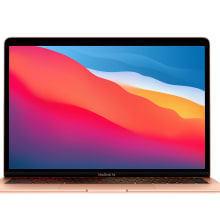
The MacBook Air M1 is still a valid work laptop that boasts a gorgeous display.
Meet the tester
Adrien has over 4 years of experience covering laptops, desktops, software, games, and more.
Checking our work.
Our team is here to help you buy the best stuff and love what you own. Our writers, editors, and experts obsess over the products we cover to make sure you're confident and satisfied. Have a different opinion about something we recommend? Email us and we'll compare notes.
Shoot us an email

